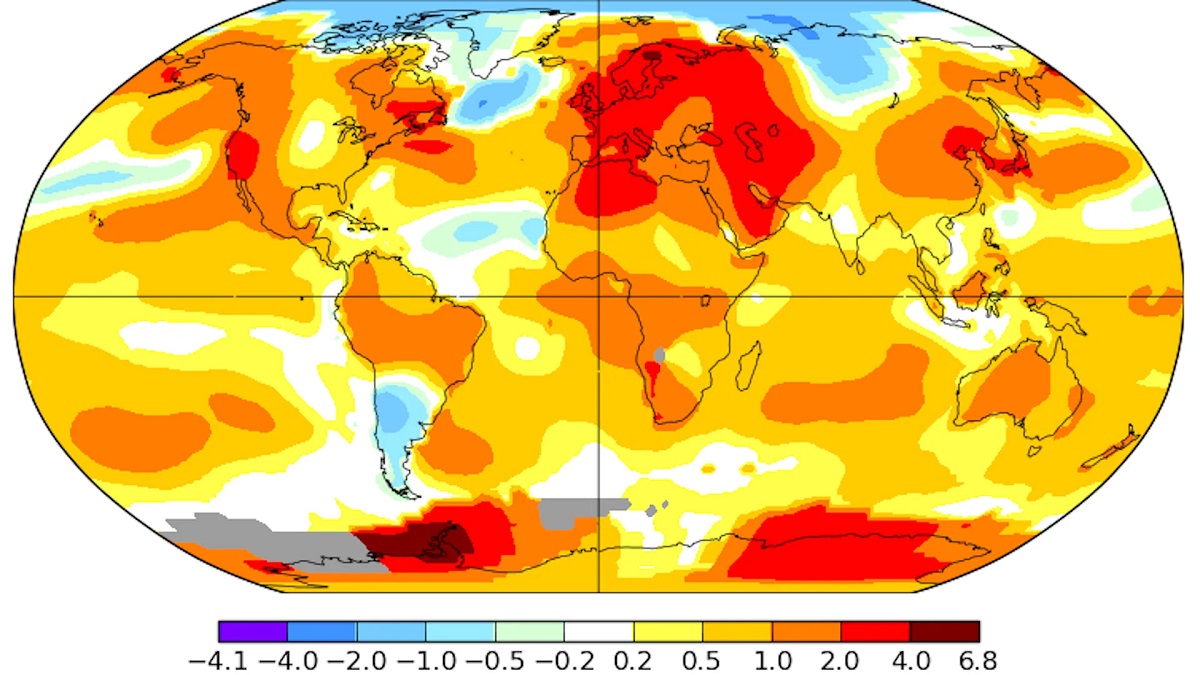Home>Science & Environment>Comparing The Temperature Of 390 Kelvin To Other Temperatures


Science & Environment
Comparing The Temperature Of 390 Kelvin To Other Temperatures
Modified: April 28, 2024
Explore the temperature of 390 Kelvin and its significance in the realm of Science & Environment. Compare it to other temperatures for a comprehensive understanding.
(Many of the links in this article redirect to a specific reviewed product. Your purchase of these products through affiliate links helps to generate commission for Temperatures.com, at no extra cost. Learn more)
Table of Contents
Introduction
Temperature is a fundamental aspect of our daily lives, influencing everything from the weather to the behavior of materials. It allows us to understand the world around us and plays a crucial role in scientific research, industrial processes, and technological advancements. In this article, we will delve into the concept of temperature, specifically focusing on the Kelvin scale and exploring the significance of 390 Kelvin in various contexts.
Understanding temperature goes beyond simply knowing whether it's hot or cold. It involves comprehending the molecular motion of substances and how it impacts their properties. The Kelvin scale, named after the eminent physicist Lord Kelvin, is an absolute temperature scale that measures temperature in relation to absolute zero, the theoretical point at which all molecular motion ceases. Unlike the Celsius and Fahrenheit scales, which are based on the properties of water, the Kelvin scale provides a more precise and universal measurement of temperature.
At 390 Kelvin, we enter the realm of elevated temperatures that have diverse implications across different fields. By comparing 390 Kelvin to the more commonly used Celsius and Fahrenheit scales, we can gain a deeper understanding of its significance. Furthermore, exploring the applications of 390 Kelvin temperature in various contexts, such as in scientific experiments, industrial processes, and environmental studies, will shed light on its practical relevance.
Join us on this exploration as we unravel the significance of 390 Kelvin temperature and its impact on the world around us. Let's embark on a journey to comprehend the implications of this temperature in our daily lives and the broader scientific and industrial landscape.
Read more: Understanding The Cooler Temperatures In Quito, Ecuador Compared To Other Equatorial Locations
Understanding Kelvin Temperature Scale
The Kelvin temperature scale, named after the renowned physicist Lord Kelvin, is an absolute temperature scale that is widely used in scientific and engineering applications. Unlike the Celsius and Fahrenheit scales, which are based on the freezing and boiling points of water, the Kelvin scale is rooted in the concept of absolute zero. This fundamental principle makes the Kelvin scale particularly valuable in scientific research and industrial processes.
At the core of the Kelvin scale is the concept of absolute zero, which is defined as the point at which all molecular motion ceases. This theoretical temperature, equivalent to 0 Kelvin, represents the lowest possible temperature in the universe. It serves as the foundation for the Kelvin scale, providing a universal reference point for measuring temperature. Unlike the Celsius and Fahrenheit scales, which use arbitrary reference points, the Kelvin scale aligns with the laws of thermodynamics and offers a more precise and consistent measurement system.
One of the key advantages of the Kelvin scale is its direct correlation with the kinetic energy of particles. As the temperature increases, the kinetic energy of particles also increases. This relationship allows scientists and engineers to make accurate calculations and predictions based on the behavior of materials at different temperatures. Additionally, the Kelvin scale is particularly well-suited for scientific experiments and calculations involving gases and other substances that approach extremely low temperatures.
In practical terms, the Kelvin scale is often used in scientific research, particularly in fields such as physics, chemistry, and materials science. It provides a standardized and universally accepted method for expressing temperature, facilitating clear communication and collaboration among researchers worldwide. Furthermore, the Kelvin scale is integral to various engineering disciplines, where precise temperature measurements are essential for designing and optimizing processes and systems.
Overall, the Kelvin temperature scale offers a comprehensive and absolute framework for understanding temperature, making it an indispensable tool in scientific, industrial, and academic settings. Its alignment with fundamental physical principles and its applicability across diverse fields underscore its significance in advancing our understanding of the natural world and driving technological innovation.
Comparing 390 Kelvin to Celsius and Fahrenheit
When comparing temperatures across different scales, such as Kelvin, Celsius, and Fahrenheit, it's essential to understand the unique characteristics and reference points of each scale. This comparison allows us to appreciate the diverse ways in which temperature is measured and expressed, providing valuable insights into the relative magnitudes of temperatures in different contexts.
At 390 Kelvin, we encounter a temperature that holds significance in various scientific, industrial, and environmental scenarios. To comprehend its magnitude in relation to the Celsius and Fahrenheit scales, let's explore the corresponding values and implications.
390 Kelvin to Celsius
In the Celsius scale, 390 Kelvin is equivalent to approximately 116.85 degrees Celsius. This conversion highlights the relatively high temperature represented by 390 Kelvin, placing it within the range of elevated temperatures. In practical terms, this temperature is notably higher than typical room temperature, emphasizing its relevance in contexts such as industrial processes, material behavior, and certain environmental conditions.
390 Kelvin to Fahrenheit
When comparing 390 Kelvin to the Fahrenheit scale, it corresponds to approximately 243.47 degrees Fahrenheit. This conversion underscores the substantial magnitude of 390 Kelvin, particularly in the context of Fahrenheit temperatures. The high value in Fahrenheit further emphasizes the significance of 390 Kelvin in scenarios where precise temperature control and understanding are crucial.
By comparing 390 Kelvin to both Celsius and Fahrenheit, we gain a comprehensive understanding of its magnitude and implications in various settings. Whether it's in the realm of scientific research, industrial processes, or environmental monitoring, 390 Kelvin represents a temperature of significance, influencing the behavior of materials, chemical reactions, and physical processes.
The comparison of 390 Kelvin to Celsius and Fahrenheit serves as a reminder of the diverse ways in which temperature is measured and interpreted, highlighting the importance of understanding temperature scales in different contexts. This knowledge enables scientists, engineers, and researchers to make informed decisions and predictions based on the precise measurement and interpretation of temperature, ultimately driving advancements in science, technology, and industry.
Applications of 390 Kelvin Temperature
At 390 Kelvin, the temperature holds significant implications across various scientific, industrial, and environmental applications. Understanding the practical relevance of this temperature provides valuable insights into its impact on materials, processes, and natural phenomena.
Industrial Processes
In industrial settings, 390 Kelvin represents a temperature range commonly encountered in manufacturing, chemical processing, and materials engineering. Many chemical reactions and industrial processes operate within this temperature range, making it crucial for optimizing production efficiency and product quality. For instance, in the production of polymers and plastics, maintaining precise temperatures around 390 Kelvin is essential for controlling the properties and characteristics of the final materials. Similarly, in metalworking and heat treatment processes, 390 Kelvin temperatures play a vital role in shaping and strengthening metallic components, contributing to the overall quality and performance of manufactured products.
Environmental Studies
In environmental science and climate research, 390 Kelvin is relevant in studying the impact of elevated temperatures on ecosystems, weather patterns, and global climate change. This temperature range aligns with extreme heat events and can provide insights into the effects of rising temperatures on natural environments. By monitoring and analyzing temperature data around 390 Kelvin, scientists can assess the resilience of ecosystems, predict heat-related phenomena, and evaluate the implications of climate change on biodiversity and ecological systems.
Scientific Experiments
In scientific laboratories and research facilities, 390 Kelvin is often utilized in experiments involving the behavior of materials, chemical reactions, and thermal properties of substances. This temperature range allows scientists to study the effects of heat on various materials, investigate phase transitions, and explore the thermal stability of compounds. Additionally, in fields such as biotechnology and pharmaceutical research, maintaining precise temperatures around 390 Kelvin is critical for conducting experiments related to protein denaturation, enzyme activity, and other biochemical processes.
Energy Generation
390 Kelvin temperatures are relevant in the context of energy generation and thermal power systems. In power plants and energy facilities, steam turbines and heat exchangers often operate at temperatures around 390 Kelvin to efficiently convert thermal energy into electricity. Understanding the behavior of materials and fluids at this temperature range is essential for optimizing the performance and efficiency of energy conversion processes, contributing to sustainable and reliable power generation.
Materials Testing and Analysis
The temperature of 390 Kelvin is integral to materials testing and analysis, particularly in evaluating the thermal properties and behavior of substances. From assessing the thermal expansion of materials to studying the effects of heat on structural integrity, this temperature range provides valuable insights for engineers, researchers, and quality control professionals. By subjecting materials to controlled temperatures around 390 Kelvin, experts can assess their performance under realistic operating conditions, informing the design and selection of materials for diverse applications.
In summary, the applications of 390 Kelvin temperature span a wide range of disciplines, from industrial processes and environmental studies to scientific research and materials analysis. Its significance in shaping materials, influencing chemical reactions, and contributing to our understanding of natural and engineered systems underscores the multifaceted impact of this temperature in diverse fields.
Conclusion
In conclusion, the temperature of 390 Kelvin holds substantial significance across various scientific, industrial, and environmental domains. By exploring its implications and comparing it to the Celsius and Fahrenheit scales, we have gained valuable insights into the magnitude and practical relevance of this temperature.
The Kelvin scale, with its foundation in absolute zero and direct correlation with molecular motion, provides a precise and universal framework for measuring temperature. At 390 Kelvin, we enter a temperature range that influences industrial processes, environmental studies, scientific experiments, energy generation, and materials analysis. This temperature serves as a critical factor in optimizing manufacturing processes, studying the impact of elevated temperatures on ecosystems, conducting scientific experiments, enhancing energy generation efficiency, and evaluating the thermal properties of materials.
The comparison of 390 Kelvin to Celsius and Fahrenheit underscores its elevated magnitude and its implications in scenarios where precise temperature control and understanding are essential. This knowledge is instrumental in guiding scientific research, industrial operations, and environmental monitoring, ultimately contributing to advancements in technology, sustainability, and our understanding of the natural world.
Overall, the temperature of 390 Kelvin represents a pivotal point in the spectrum of temperatures, shaping the behavior of materials, influencing chemical reactions, and providing valuable insights into the thermal characteristics of substances. Its multifaceted applications underscore its significance in driving innovation, fostering sustainable practices, and expanding our knowledge across diverse fields.
As we continue to explore the intricate relationship between temperature and its impact on the world around us, the significance of 390 Kelvin serves as a reminder of the profound influence of temperature on scientific discovery, industrial processes, and environmental dynamics. Embracing the complexities and implications of this temperature range enriches our understanding of the natural and engineered systems that shape our world.













